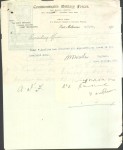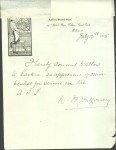LARKINS, William James
William James Larkins was the son of William John Larkins, labourer, and Annie Teresa Browne. He was born in Richmond on 24 October 1898, only 16 years and 8 months at the time of his enlistment on 3 July 1915, rather less than the 18 years and 2 months he claimed. He was at the time three years into a five-year apprenticeship as a leadlighter with William Montgomery, a leading exponent in the art of stained glass. He had served four years with the senior cadets in area 64B, based at the drill hall on the corner of Powlett Street and Victoria Parade. He gave as his next of kin, his mother, Annie Larkins, then living at 32 Darling Street, East Melbourne. Annie was the daughter of James Peel Browne senior who, until his death in 1905, had operated a livery stables and cab business around the corner in Grey Street. Her brother, also James Peel Browne, who also died in 1905, had operated a coachbuilding business in the workshop next door to where she was living. By 1915 however it was no longer in the family’s hands and had converted to a motor garage. Annie was required to supply a letter of consent in view of William’s young age, and his employer was also required to consent to his release from apprenticeship. William was 5ft 10½ins and 11st 6lbs, and would have been considered a big man for his time.
He was officially enrolled on 22 September 1915 with the 14th Battalion, 9th Reinforcements. He embarked for overseas on 27 September aboard HMAT Hororata. He arrived at Moascar, Egypt on 8 January 1916. On 17 March 1916 he was transferred to the newly created 4th Pioneer Battalion and taken on strength at Tel-el-Kebir. On 4 June he proceeded with his unit to Alexandria for embarkation to Marseilles and on to the Western Front. Pioneer battalions performed construction tasks in the forward area not requiring the special equipment of engineers, such as constructing trenches and dugouts although they occasionally acted in the engineer role on tasks such as the construction of bridges. They had a large proportion of tradesmen and were organised the same as infantry battalions. In a pinch they could and did serve as infantry in the front line. William appears to have a had a remarkably uneventful war with his service record mainly filled with temporary promotions and reversions, and periods of leave, once in Paris and once in England. He returned to Australia on HMS Cluny Castle on 21 May 1919, and was demobilised soon after.
The 1922 electoral roll has William living back at 32 Darling Street with his parents and employed as a rubber worker. Later he moved with his mother to addresses in Middle Park and Albert Park and following in his father’s footsteps, worked as a labourer. He served in WWII but his record is not yet publicly available. He never married. He died on 11 December 1968 at the Repatriation General Hospital in Heidelberg.


